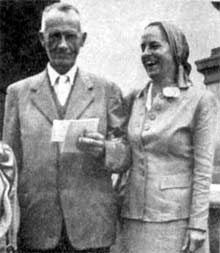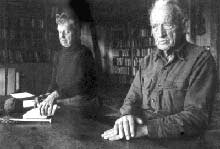|


May 24, 2008
My husband and I once rescued a stray kitten while visiting Romania, his birthplace, and urged the kitten on a friend there who had never owned a cat. This was still in Communist times, and pet ownership was rare because most people had trouble feeding themselves, much less any four-leggeds. What most Romanians knew of cats came from seeing them trot by intently in some storeroom or farmyard, going about their feline business with barely a glance for humans, unless there was food to be had.
This kitten was astonished to be petted, and all but swooned under a stroking hand. After our friend had lived with her new charge for a few days, we asked how it was going. “This is not a cat,” our friend said almost indignantly, as if we had tricked her. “This is a cross between a dog and a monkey!”
Not bad, not bad at all, as a description of what cats are really like when you get to know them: as affectionate as a dog, as clever as a monkey. (Only Japanese people are as different when you know them intimately—as passionate as Sicilians!—from the cool, impassive way they appear in public.) It’s not just cats’ curiosity that is almost simian, or their expressive tails, or the hand-like use of their paws to open cabinets and the like. It’s that they could give any macaque a run for his “monkey see, monkey do.”
Mirror neurons, the brain cells thought to fire in sync and sympathy when we watch someone’s purposeful movements or facial expressions, were first discovered and named in macaque monkeys in the mid-1990s by Vittorio Gallese, Giovanni Rizzolatti, and colleagues in the Department of Neurosciences at the University of Parma, Italy. Individual neurons in two linked areas of the monkeys’ brains (these links lead to articles by the original researchers) would fire not only when the monkeys performed a particular goal-directed action, such as reaching for food, but also when they saw another monkey—or even a human being—performing the same action. The researchers found a class of mirror neurons that fired at the recognizable sound of an action, as well as others that were triggered by the sight of communicative facial expressions.
In the decade since, the original researchers and others, notably including Marco Iacoboni, the brain-imaging pioneer now at the David Geffen School of Medicine, UCLA, who wrote our featured May article “Mental Mirrors,” have shown that two corresponding areas of the human brain, in the premotor and parietal cortex, light up when people perform or observe someone else performing the same action. In effect, when we watch a meaningful movement or facial expression, we internally mimic or participate in it, feeling it in our own muscles and gut—not just recognizing it intellectually but experiencing it viscerally. It’s not much of a stretch to begin to see how momentous such a mechanism could be, what a vast range of human capacities it might facilitate. As the University of California San Diego’s V.S. Ramachandran wrote in a landmark essay:
I predict that mirror neurons will do for psychology what DNA did for biology: they will provide a unifying framework and help explain a host of mental abilities that have hitherto remained mysterious and inaccessible to experiments.
Such as:
- Action recognition: understanding what another person is doing
- Intention recognition: understanding what other people intend by their actions, and even what they are probably thinking and feeling; “mind reading”
- Prediction: having a good sense of what others are likely to do next
- Learning: rapid transmission of useful skills and actions by mimicry; therefore, culture, and possibly language (see also the Ramachandran link above)
- Rapport: falling into tune (PDF) with others by mirroring them, usually unconsciously (but Neuro-Linguistic Programming, or NLP, teaches how to do it deliberately, to influence people, win their trust, even seduce them); therefore, social bonding, cooperation—and the resemblance between long and happily married spouses.
- Empathy: personally experiencing another person’s emotions, as expressed by his or her face and body language (which people with autism, strikingly, cannot “read”); therefore, morality, based on the Golden Rule
- Philosophical ethics: Paul Ricoeur’s recognition that “the other is also a self”; Martin Buber’s “I and Thou”; the “Theory of Other Minds”
That’s a hell of an explanatory load to place on a single, relatively simple brain mechanism, and mirror neurons certainly have their skeptics. Berkeley psychology professor Alison Gopnik has called them a “myth” and a fad comparable to the “left brain/right brain” craze of the 1960s; she points out that because we don’t poke electrodes into healthy human brains, “no one knows for sure if humans even have mirror neurons.” Right now, however, those voices are in the minority, and an explosion of research is going forward on the assumption that humans do.
What I want to know, though, is whether cats have mirror neurons.
It’s not just a whimsical question. One of the things we’ll need to look into is where on the phylogenetic tree such cells may have arisen, and how widespread they are among living organisms. So far, they have only been studied in monkeys. Yet any creature that has even a rudimentary social life (and arguably every mouse mama with a litter is in a temporary social grouping) could use them, and animals that learn from one another could hardly do without them. Felines learn the tricks of the hunt from their mothers, and it would serve them well in the wild to be keen observers and gifted mimics.
(It makes me uneasy to be raising the question, lest it give added impetus to someone who wants to poke electrodes into living cats’ brains. A lot of that goes on, I know. There was a contentious spat about it at the AMNH (PDF) over thirty years ago, and I have to admit I was on the other side at the time. I guess what bears saying here is that to do experimental science on higher mammals you have to disengage your mirror neurons, and view them as unsentimentally as a Romanian peasant would, while to regard them as family members or fellow “selves,” you have to engage those circuits full speed ahead. The whole point of this post is that mimicry and empathy are possible not only within species but between them, and that suggests that mirror neurons, if they really are the underlying mechanism, may be very widespread indeed.)
Mirror neurons may come with some innate coding, but for the most part they apparently “learn” from experience of recurring sequences to interpret and predict others’ actions. That would explain the phenomenon reported in one of our April Samplings, “The Dog’s Meow”: dogs and cats that live together learn to respond appropriately to each other’s different, sometimes opposite, body languages. We humans, too, can easily wire up our brains to understand the intentional and emotional “dialects” of other species. (And even speak them: I’ve been caught hissing back at my cats. “You don’t anthropomorphize your cats,” my brother says. “You’ve felinomorphized yourself!”) But do those species reciprocate?
Well, I have two cats who, not to put too fine a point on it, have taught themselves to pee on the toilet. In it.
There are elaborate systems for teaching a cat to do this—small round kitty-litter pans to place down in the bowl, etc. No such thing was involved.
They just figured it out for themselves, motivated, I think, by some kind of “when in Rome, do as the Romans do” sentiment. There is no escaping the conclusion that one of them, Dito, my most brilliant feline engineer (coincidentally or not, he’s Korean), taught himself by observing us. He must have taken measurements from several angles, like a surveyor, because he does it perfectly, straight down the middle, tinkling sound and all. Buzzy, I think, taught himself by observing Dito, but he added a fillip that could only come from direct observation of humans and a kind of approximate “intention recognition.” Buzzy pawed the roll of toilet paper and unrolled it into the toilet when he could, onto the floor if he couldn’t. He seems to have reasoned that unrolling toilet paper was roughly the human equivalent of covering your deposit with kitty litter. When I started turning the rolls around for the sake of my toilet-paper budget, Buzzy got disgusted and quit, but Dito still uses the toilet.
One or two readers of my personal blog were grossed out by my posting these photographs of Buzzy. In case anyone here is offended, I apologize in advance. But I’m posting them in the name of science. If that ain’t mirror neurons, I say there’s no such thing.


(Annie Gottlieb) |
Comments (add yours!)

Return to May home
|





